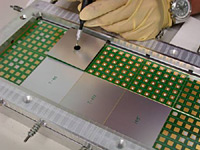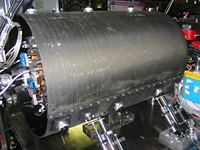 |
|
|
 |
Review of the French ILC Detector R&D

W/Si ECAL prototype assembly – Silicium wafers glued on the printed circuit board |
The French ILC community held a SOCLE meeting (Seminar Oriented towards a Contribution to an Electron Linear Collider) in Lyon on 12-13 January 2006. More than 70 participants attended a review of the ongoing ILC detector R&D effort in CNRS/IN2P3 and CEA/DAPNIA laboratories. Future prospects and organisation aspects were discussed. Software tools dedicated to physics analyses and detector optimisation were also debated, in preparation for the Detector Conceptual Report, which will be delivered to the GDE by the end of 2006.
One of the main French contributions is the electromagnetic calorimeter (ECAL), within the CALICE (Calorimeter for the Linear Collider with Electrons) international collaboration. Recently, some effort has also been directed towards another calorimeter collaboration.
Another important study is on microvertex detectors based on CMOS technology (Complementary Metal-Oxide Semiconductor). R&D to improve charged particle tracking is also pursued within the SiLC (Silicon tracker for the Linear Collider) and LC-TPC (Time Projection Chamber) international collaborations.
Read more...
Slides | Photos of Meeting
--Perrine Royole-Degieux |
 |
|
|
 |
GDE Area System Leaders Meet in KEK
The GDE Executive Committee, Area System Leaders, and Chairmen of the Change Control and Design & Cost Boards met in the KEK Laboratory in Tsukuba, Japan (19-20 January 2006). (See this weeks Director’s Corner) Technical and cost discussions included the configuration of the main linac unit, the overall machine layout, including site dependent differences, and the relationship between the Low Q (small charge per bunch, but many bunches) parameter set and the operating flexibility of the Damping Rings. The agenda and links to the presentations and discussions can be found online.
Read more...
--Peter Garbincius |
|
 |
 |
|
|
 |
EUDET Kick-off Meeting
The start of the European Union funded EUDET project is marked by a Kick-off Meeting at DESY on 15 to 17 February, 2006. The project assembles 31 European institutes and 20 international associates to prepare infrastructures to allow for ILC detector R&D with larger prototypes (see Newsline, 8 September 2005).
At this first workshop for the EUDET project, all participating institutes and associates will convene to discuss the scientific programme with emphasis on ideas and plans for the coming months. EUDET encompasses support for the development of vertexing, tracking and calorimeter prototypes, as well as for the simulation and analysis software framework. The participants consider this programme to be completely embedded in the international R&D efforts towards the ILC detector. Therefore the workshop is open to all interested institutes, which are cordially invited to attend the meeting and contribute ideas to optimally exploit the EU funding.
More information and the registration form can be found on the developing web site http://www.eudet.org.
-- Joachim Mnich, DESY
|
 |
|
|
 |
Finding the nano-size beam

RF cavity beam position monitor being developed by the NanoBPM Collaboration. |
The International Linear Collider (ILC) interaction region beam sizes and
component position stability requirements will be as small as a few
nanometers. Making a head-on collision with a few nanometers beams,
each beam travelling across some 20 km in the linear accelerator, is a
bit like colliding two baseballs -- one thrown from earth and the other
from Saturn! It is important for the ongoing ILC design effort to
demonstrate that these tolerances can be achieved -- ideally using a
beam-based stability measurement.
Read more... -- Sean Walston and Youhei Morita |
 |
|
|
 |
From SLAC
23 January 2006
ILC Test Beam Experiments at SLAC
Earlier this month, SLAC researchers commissioned a test beam in End Station A (ESA) for a series of experiments to test components for the proposed International Linear Collider. At 40 kilometers long, the multi-national machine would be the world’s largest and most powerful electron collider.
SLAC is one of the few places in the world where this kind of work can be done. Mike Woods (LCD) said the work is necessary if researchers hope to achieve the predicted luminosity and precision capabilities for the giant accelerator.
Read more...
From Congressional Quarterly
16 January 2006
Science on a Shoestring
"...Is there any way to get it back? Maybe: A next-generation particle accelerator is already on the drawing board. Later this year, a global team of scientists will decide where to build the International Linear Collider, whose electron-positron collisions, the team says, 'would give it the capability to answer compelling questions that discoveries at the LHC will raise, from the identity of dark matter to the existence of extra dimensions'..."
Read more... |
|
 |
 |
|
|
 |
RDR Kick-off
Our major theme for the past six months has been to establish a basic "configuration" for the International Linear Collider. The GDE process got underway last August at Snowmass and culminated in our approval of a "strawman" configuration at a meeting in Frascati, Italy in December. That work resulted in a Baseline Configuration Document (BCD) that now is forming the starting point and the basis for our new major theme for this calendar year, which is to develop a "design and cost" for this collider concept.

Kaoru Yokoya |
The process of transitioning to this new mode began in earnest this past week at the first meeting of "GDE Area Systems Leaders" at KEK. That meeting was organized by our regional accelerator leaders, Tor Raubenheimer, Nick Walker and Kaoru Yokoya. The goal of the meeting was to give guidance (or marching orders) to the leaders of the teams who are responsible for carrying out the actual design and costing. We are now calling these design teams "Area Systems" groups. These groups have evolved from the original working groups, who created the BCD. The six groups are e- source, e+ source, damping rings, ring to main linac, main linac and beam delivery systems. The names are changed to represent the fact that the groups now have decidedly more emphasis on engineering and costing. In doing the design and costing, these groups will be supported by other groups in a matrix like structure that cross these different areas of the machine -- either technical systems like vacuum systems, magnet systems, instrumentation, etc., or global systems like controls, conventional facilities and reliability. These pieces all have to work together in a way that produces a coherent design with reliable costing.
All of this sounds rather complicated, but what I have just described is only a way to break down the problem of doing the design into its pieces. At the KEK meeting, the charges for the area systems were discussed in the context of a timeline that will produce a Reference Design Report (RDR) this calendar year. This report is to be a technical document describing the collider with a construction cost and schedule. To achieve this goal, we delineated a set of major milestones for the GDE meetings in Bangalore in March and in Vancouver in July.
Within all this seemingly cumbersome, but essential, discussion of organizational issues at KEK (see accompanying meeting summary by Peter Garbincius), were some very lively discussions of technical issues. One discussion that particularly stood out at the KEK meeting involved a presentation of timing issues for the damping rings by Andy Wolski, and in particular, the allowed flexibility for different fill patterns depending on the relationship between the diameter of the damping ring and other critical lengths in the collider. This may sound like an academic issue, but in fact it reflects itself in the final operational flexibility of the collider, in terms of allowing different bunch spacing and fill patterns while maintaining beam collisions.
I believe that, upon reflection, we will mark the KEK meeting as the beginning of this new and challenging phase of our work within the GDE -- one where we are concentrating on developing a design and costing for the reference design, and especially one with cost consciousness built into every corner of our process. Our goals and time scales are very ambitious, but if we can capture the momentum that was developed at KEK we will quickly be on our way.
--Barry Barish
Director's Corner Archive |
 |
|
|
 |
RSS Feed Now Available for NewsLine
Read More
ILC Related Preprints
hep-ph/0601142
17 Jan 2006
TeV-Scale Stringy Signatures at the Electron-positron Collider
hep-ph/0601199
25 Jan 2006
Space-time structure of new physics with polarized beams at the linear collider |
|

